ATTRACTIONS
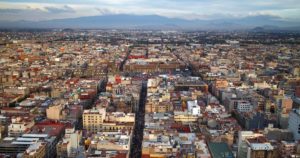 Mexico City is the capital of Mexico and the most populous city in North America and the largest Spanish-speaking city in the world. Mexico City is one of the most important cultural and financial centers in the Americas. As the world’s sixth largest city, it is a destination for many tourists.The historic center and the “floating gardens” of Xochimilco in the southern borough have been declared World Heritage Sites by UNESCO. The most recognizable icon of Mexico City is the golden Angel of Independence on the wide, elegant avenue Paseo de la Reforma. This avenue was designed over the Americas’ oldest known major roadway in the 19th century to connect the National Palace with the Castle of Chapultepec. Chapultepec is one of the biggest urban parks in the world and houses the Chapultepec Castle, lakes, monuments, and the national zoo, and the National Museum of Anthropology. The Basilicas of Our Lady of Guadalupe draws pilgrims from around the world every day. The city has about 160 museums – the world’s greatest single metropolitan concentration – over 100 art galleries, and some 30 concert halls.
Mexico City is the capital of Mexico and the most populous city in North America and the largest Spanish-speaking city in the world. Mexico City is one of the most important cultural and financial centers in the Americas. As the world’s sixth largest city, it is a destination for many tourists.The historic center and the “floating gardens” of Xochimilco in the southern borough have been declared World Heritage Sites by UNESCO. The most recognizable icon of Mexico City is the golden Angel of Independence on the wide, elegant avenue Paseo de la Reforma. This avenue was designed over the Americas’ oldest known major roadway in the 19th century to connect the National Palace with the Castle of Chapultepec. Chapultepec is one of the biggest urban parks in the world and houses the Chapultepec Castle, lakes, monuments, and the national zoo, and the National Museum of Anthropology. The Basilicas of Our Lady of Guadalupe draws pilgrims from around the world every day. The city has about 160 museums – the world’s greatest single metropolitan concentration – over 100 art galleries, and some 30 concert halls.
 Guadalajara is the capital and largest city of Jalisco, and is the fifth-most-populous city in Mexico. Much of its architecture dates from the independence period. Guadalajara’s historical center has an excellent assortment of museums, theaters, galleries, libraries, auditoriums, concert halls, colonial plazas and landmarks such as the neoclassical Teatro Degollado (the oldest opera house in Mexico). Hospicio Cabañas is one of the oldest and largest hospital complexes in the Americas, and home to some of the paintings by Jose Clemente Orozco. It was declared a World Heritage Site by UNESCO in 1997. The historic downtown of Guadalajara is the oldest section of the city. Accessible by walking or horse drawn carriages, it is a bit expensive but it feels like travelling in a previous century. Within Guadalajara’s historic downtown, there are many squares and public parks which surround the cathedral to form a Latin Cross. It is a lovely city, known for its tequila and mariachi music and host to a number of large-scale cultural events. Guadalajara also is the main producer of software, electronic and digital components in Mexico and nicknamed as “Silicon Valley of Mexico”. FDI magazine ranked Guadalajara highest among major Mexican cities and designated Guadalajara as having the second strongest economic potential of any major North American city, behind Chicago. The magazine also ranked it as the most business-friendly Latin American city in 2007.
Guadalajara is the capital and largest city of Jalisco, and is the fifth-most-populous city in Mexico. Much of its architecture dates from the independence period. Guadalajara’s historical center has an excellent assortment of museums, theaters, galleries, libraries, auditoriums, concert halls, colonial plazas and landmarks such as the neoclassical Teatro Degollado (the oldest opera house in Mexico). Hospicio Cabañas is one of the oldest and largest hospital complexes in the Americas, and home to some of the paintings by Jose Clemente Orozco. It was declared a World Heritage Site by UNESCO in 1997. The historic downtown of Guadalajara is the oldest section of the city. Accessible by walking or horse drawn carriages, it is a bit expensive but it feels like travelling in a previous century. Within Guadalajara’s historic downtown, there are many squares and public parks which surround the cathedral to form a Latin Cross. It is a lovely city, known for its tequila and mariachi music and host to a number of large-scale cultural events. Guadalajara also is the main producer of software, electronic and digital components in Mexico and nicknamed as “Silicon Valley of Mexico”. FDI magazine ranked Guadalajara highest among major Mexican cities and designated Guadalajara as having the second strongest economic potential of any major North American city, behind Chicago. The magazine also ranked it as the most business-friendly Latin American city in 2007.
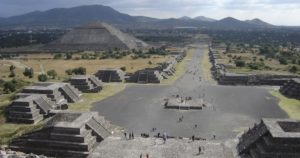 Teotihuacan known as the City of the Gods, is a vast Mexican archaeological complex northeast of Mexico City and was designated a UNESCO World Heritage Site in 1987. According to legend, it was here where the gods gathered to plan the creation of man. Running down the middle of the site, which was once a flourishing pre-Columbian city, is the Avenue of the Dead. It is one of the most noted archaeological attractions in Mexico, receiving 4,185,017 visitors in 2017. Teotihuacan was one of the largest and most important pre-Aztec cities in Mexico, this site has a lot of small pyramids, but there are four main attractions: The Temple of the Moon – is the second largest pyramid off from the center of the complex. The Temple of the Sun – is one of the largest structures of its type in the Western Hemisphere and the largest pyramid in the city of Teotihuacan that offers an excellent view of the surrounding mountains. The Temple of Quetzalcoatl – is the third largest pyramid. It is one of the most sacred Temples in the complex. This temple is decorated with many stone serpent heads. There are also some smaller structures surrounding the complex. A drive around the perimeter, on the road along the park will provide many surprises and is worth the trip. There are also many interesting constructions along the Avenue of the Dead which runs along the middle of the site. On the left side of the plaza in front of the Temple of the Moon are several areas including the Palace of the Jaguars which house many wall paintings, sculptures, and underground rooms. There is also museum at the park with outstanding displays and a miniature recreation of the entire site.
Teotihuacan known as the City of the Gods, is a vast Mexican archaeological complex northeast of Mexico City and was designated a UNESCO World Heritage Site in 1987. According to legend, it was here where the gods gathered to plan the creation of man. Running down the middle of the site, which was once a flourishing pre-Columbian city, is the Avenue of the Dead. It is one of the most noted archaeological attractions in Mexico, receiving 4,185,017 visitors in 2017. Teotihuacan was one of the largest and most important pre-Aztec cities in Mexico, this site has a lot of small pyramids, but there are four main attractions: The Temple of the Moon – is the second largest pyramid off from the center of the complex. The Temple of the Sun – is one of the largest structures of its type in the Western Hemisphere and the largest pyramid in the city of Teotihuacan that offers an excellent view of the surrounding mountains. The Temple of Quetzalcoatl – is the third largest pyramid. It is one of the most sacred Temples in the complex. This temple is decorated with many stone serpent heads. There are also some smaller structures surrounding the complex. A drive around the perimeter, on the road along the park will provide many surprises and is worth the trip. There are also many interesting constructions along the Avenue of the Dead which runs along the middle of the site. On the left side of the plaza in front of the Temple of the Moon are several areas including the Palace of the Jaguars which house many wall paintings, sculptures, and underground rooms. There is also museum at the park with outstanding displays and a miniature recreation of the entire site.
TRAVEL ADVENTURE
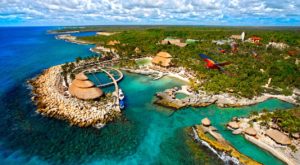 Mexico has traditionally been among the most visited countries in the world. The most notable attractions are the Meso-American ruins, cultural festivals, colonial cities, nature reserves and the beach resorts. On the Yucatan peninsula, one of the most popular beach destinations is Riviera Maya is a tourism and resort district south of Cancun, Mexico. It is famous for its large scale all-inclusive resorts and a historical tourism base of smaller boutique hotels as well as the many fine-dining restaurants available along the Fed 307 and on or near the beaches. A major attraction throughout the Riviera Maya are coastal and reef aquatic activities dependent on the coastal water and the Meso-American Barrier Reef System which begins near Cancun and continues along the whole length of the Riviera Maya continuing southward to Guatemala. This barrier reef system is the second longest in the world. Activities at the most visited locations include jet-skiing, snorkeling, scuba diving, swimming in cenotes, swimming with dolphins, zip-lining, horse riding, sailing, and guided jungle tours.
Mexico has traditionally been among the most visited countries in the world. The most notable attractions are the Meso-American ruins, cultural festivals, colonial cities, nature reserves and the beach resorts. On the Yucatan peninsula, one of the most popular beach destinations is Riviera Maya is a tourism and resort district south of Cancun, Mexico. It is famous for its large scale all-inclusive resorts and a historical tourism base of smaller boutique hotels as well as the many fine-dining restaurants available along the Fed 307 and on or near the beaches. A major attraction throughout the Riviera Maya are coastal and reef aquatic activities dependent on the coastal water and the Meso-American Barrier Reef System which begins near Cancun and continues along the whole length of the Riviera Maya continuing southward to Guatemala. This barrier reef system is the second longest in the world. Activities at the most visited locations include jet-skiing, snorkeling, scuba diving, swimming in cenotes, swimming with dolphins, zip-lining, horse riding, sailing, and guided jungle tours.
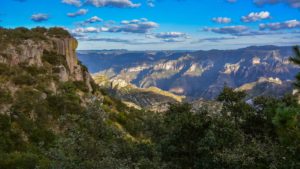 In the Sierra Madre Occidental in the southwestern part of the state of Chihuahua in northwestern Mexico is where Copper Canyon located. It is a group of six distinct canyons. These canyons were formed by six rivers that drain the western side of the Sierra Tarahumara. All six rivers merge into the Rio Fuerte and empty into the Gulf of California. The walls of the canyon are a copper/green color, which is the origin of the name. There are many other ways to explore Copper Canyon such as hiking, biking, driving or horseback riding. The most popular way is by train, as the Ferrocarril Chihuahua al Pacifico or ChePe, runs along the main canyon called Canyon Urique, between Chihuahua and Los Mochis, on the Gulf of California. The trip through Chihuahua’s Copper Canyon – introduces you to the high mountains and deep gorges of this region of northern Mexico. This is probably one of the most impressive train rides you’ll ever take.
In the Sierra Madre Occidental in the southwestern part of the state of Chihuahua in northwestern Mexico is where Copper Canyon located. It is a group of six distinct canyons. These canyons were formed by six rivers that drain the western side of the Sierra Tarahumara. All six rivers merge into the Rio Fuerte and empty into the Gulf of California. The walls of the canyon are a copper/green color, which is the origin of the name. There are many other ways to explore Copper Canyon such as hiking, biking, driving or horseback riding. The most popular way is by train, as the Ferrocarril Chihuahua al Pacifico or ChePe, runs along the main canyon called Canyon Urique, between Chihuahua and Los Mochis, on the Gulf of California. The trip through Chihuahua’s Copper Canyon – introduces you to the high mountains and deep gorges of this region of northern Mexico. This is probably one of the most impressive train rides you’ll ever take.
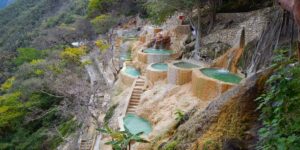 Tolantongo is a box-canyon deep in the Valley of Mezquital, state of Hidalgo in Mexico. The resort is made up of three hotel complexes and heated pools near the bottom of a steep box canyon that has walls as much as 500 meters high. Its main attraction are two grottos at the canyon’s closed end, out of which flows a small volcanically-heated river which follows the canyon floor. The large grotto chamber is about half the size of a tennis court with a ceiling of up to ten metres. Above the grotto is a “tunnel”, a small cavern 15 metres deep in which warm water showers those who venture inside. Around these two openings, warm waterfalls flow down the steep canyon walls. Here visitors can practice hiking, rappelling and spelunking. In both grottos, one can listen to the echoes of the waterfalls inside the mountain. On various sections of the canyon walls are man-made semi-circular “chapoteaderos” or splashing pools, created by damming small warm springs. Most of these are shaded by trees, allowing tourists to bath in warm waters while overlooking the canyon at the same time. Decorated caverns, powerful waterfalls, natural thermal springs, and a bright blue river system make the box canyon resort a beautiful place to visit.
Tolantongo is a box-canyon deep in the Valley of Mezquital, state of Hidalgo in Mexico. The resort is made up of three hotel complexes and heated pools near the bottom of a steep box canyon that has walls as much as 500 meters high. Its main attraction are two grottos at the canyon’s closed end, out of which flows a small volcanically-heated river which follows the canyon floor. The large grotto chamber is about half the size of a tennis court with a ceiling of up to ten metres. Above the grotto is a “tunnel”, a small cavern 15 metres deep in which warm water showers those who venture inside. Around these two openings, warm waterfalls flow down the steep canyon walls. Here visitors can practice hiking, rappelling and spelunking. In both grottos, one can listen to the echoes of the waterfalls inside the mountain. On various sections of the canyon walls are man-made semi-circular “chapoteaderos” or splashing pools, created by damming small warm springs. Most of these are shaded by trees, allowing tourists to bath in warm waters while overlooking the canyon at the same time. Decorated caverns, powerful waterfalls, natural thermal springs, and a bright blue river system make the box canyon resort a beautiful place to visit.
THE PEOPLE
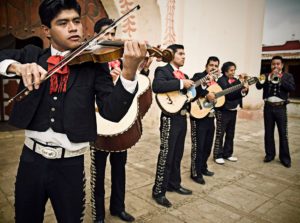 Mexico is the product of a rich Indian heritage combined with three centuries of Spanish infusion. Today, most Mexicans are mestizos, which means they have a mix of Indian and Spanish blood. Mexico has become famous worldwide due to its music. Mexican society enjoys a vast array of music genres, showing the diversity of Mexican culture. Traditional music includes Mariachi, Banda, Norteño, Ranchera and Corridos. These styles have become symbolic, and their well known songs are adored by millions. On an everyday basis most Mexicans listen to contemporary music such as rock, ska, hip hop, reggae-ton, and salsa.
Mexico is the product of a rich Indian heritage combined with three centuries of Spanish infusion. Today, most Mexicans are mestizos, which means they have a mix of Indian and Spanish blood. Mexico has become famous worldwide due to its music. Mexican society enjoys a vast array of music genres, showing the diversity of Mexican culture. Traditional music includes Mariachi, Banda, Norteño, Ranchera and Corridos. These styles have become symbolic, and their well known songs are adored by millions. On an everyday basis most Mexicans listen to contemporary music such as rock, ska, hip hop, reggae-ton, and salsa.
Mexicans also take sports seriously. In ancient times, the “Ball Game” was played as a ritual to honor the Gods. Captain of the losing team, or sometimes the entire team, were sacrificed to the gods. Later, other sports, such as horse riding and bullfighting were brought over by Spanish conquerors and gained great popularity. Today, football is the most popular team sport in Mexico which has become the national pastime.